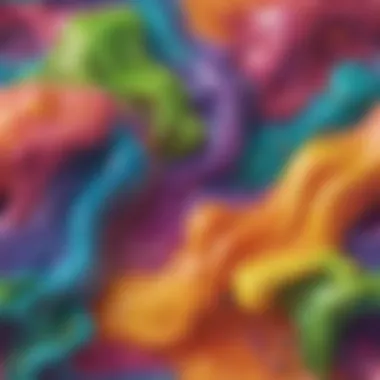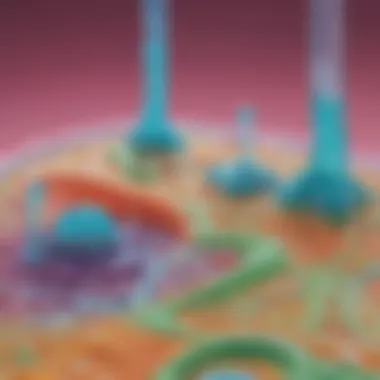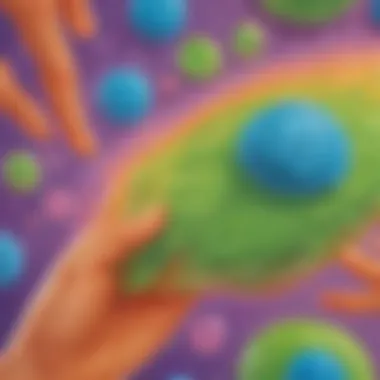Discover the Fascinating World of Slime for Young Science Enthusiasts


Science Fun Facts
Slime, a gooey and stretchy substance, has enthralled young minds for ages with its fascinating properties. Did you know that slime is a non-Newtonian fluid, behaving differently under various conditions? It can switch between liquid and solid states, making it a standout material for exploration. Young science enthusiasts can dive deeper into slime's mesmerizing characteristics through engaging hands-on activities and experiments.
Discover the Wonders of Science
Embarking on a journey to uncover the secrets of slime opens up a world of scientific wonders. By exploring the viscosity, elasticity, and chemical reactions involved in slime-making, children gain valuable insight into fundamental scientific concepts. Through educational videos, animations, and interactive tools, young minds can witness the real-life applications of science in a playful and captivating manner.
Science Quiz Time
Engaging in interactive quizzes and brain teasers centered around slime can challenge young learners to test their knowledge and critical thinking skills. Multiple-choice questions and puzzles offer an entertaining yet educational way to deepen understanding. By incorporating gamification into the learning process, children can enhance their grasp of scientific principles while having fun.
Science Experiment Showcase
The highlight of delving into the fun world of slime lies in conducting hands-on experiments. From creating slime with various textures to observing its behavior under different stimuli, these experiments allow children to apply what they've learned in a practical setting. Step-by-step instructions, a detailed materials list, and safety tips ensure a safe and engaging scientific exploration for young science enthusiasts.
Introduction to Slime
In the vast landscape of scientific exploration lies a peculiar and intriguing subject known as slime. This article embarks on a journey to unravel the mysteries and wonders of slime for young science enthusiasts, providing a blend of entertainment and education. By dissecting the elements that constitute slime, children aged 6-12 can engage in a world where science meets fun, fostering curiosity and experimentation.
What is Slime?
Definition of Slime
Slime, defined as a viscous and gooey substance, holds a pivotal role in our exploration. Its essence captivates young minds with its uniquely tactile properties, encouraging tactile sensory development and scientific inquiry. The versatility of slime as a learning tool is unmatched, allowing for hands-on engagement and practical application of scientific concepts. The definition of slime serves as the gateway to a world where children can blend fun with learning, making it a cornerstone of this article's narrative.
Properties of Slime
The properties of slime encompass a spectrum of characteristics, from its stretchiness to its elasticity. These attributes not only make slime an engaging play material but also a valuable educational resource. By understanding the properties of slime, young scientists can explore concepts like viscosity and polymer science in a tangible and exciting manner. Despite its messy nature, the benefits of slime in fostering creativity and fine motor skills cannot be overstated, making it a versatile and valuable topic for exploration.
History of Slime


Origins of Slime
The origins of slime trace back to ancient times, where natural substances were combined to create primitive versions of this fascinating goo. Through the evolution of experimentation and creativity, slime has become a staple in scientific exploration for children worldwide. Its historic roots provide a rich tapestry of discovery and innovation, rendering slime a timeless and cherished component of scientific play.
Evolution of Slime in Popular Culture
The evolution of slime in popular culture mirrors its journey from simple chemistry experiments to a ubiquitous icon of childhood entertainment. From classic movies to modern DIY trends, slime has transcended generations, leaving an indelible mark on the collective imagination. Exploring how slime has permeated popular culture offers young enthusiasts a glimpse into the dynamic and ever-evolving landscape of scientific recreation, adding depth and context to their exploration.
Science Behind Slime
In this section, we will delve into the intricate world of slime from a scientific standpoint, shedding light on the crucial aspects that make slime such a fascinating substance for young minds. Understanding the science behind slime is paramount as it allows children to grasp the chemical reactions and properties that govern this gooey material. By exploring the underlying concepts, youngsters can cultivate a deeper appreciation for the magic of slime and its applications in various experiments and activities.
Chemistry of Slime
Polymer Molecules in Slime
When we talk about the chemistry of slime, the role of polymer molecules cannot be overlooked. These long chains of molecules give slime its unique stretchy and malleable characteristics. By exploring the composition of polymer molecules in slime, children can gain insight into the molecular structure that provides slime with its fascinating properties. Understanding how these molecules interact and bond can offer a scientific foundation for young minds venturing into the world of polymers and chemical compounds.
Cross-linking and Viscosity
Another critical aspect of slime chemistry is the phenomenon of cross-linking and its impact on viscosity. Cross-linking refers to the bonds formed between polymer chains, influencing the thickness and flow of slime. By examining the role of cross-linking in slime, children can comprehend why some slimes are runny while others have a firmer texture. Understanding viscosity can spark curiosity about fluid dynamics and the behavior of materials under different conditions.
Types of Slime
Non-Newtonian Slime
Non-Newtonian slime is a fascinating variant that defies conventional fluid mechanics. Its unique characteristic lies in its ability to change viscosity depending on the force applied. This property introduces children to the concept of shear-thickening materials, where the response to pressure alters the flow behavior. Exploring non-Newtonian slime can open doors to discussions about material science and the dynamic nature of substances in response to external stimuli.
Glow-in-the-Dark Slime
Glow-in-the-dark slime adds an exciting twist to traditional slime play, incorporating luminescent pigments for an intriguing visual effect. The incorporation of glowing elements introduces children to the wonders of light reflection and material luminescence. Through creating and observing glow-in-the-dark slime, youngsters can explore the intersection of chemistry and optics, sparking an interest in how certain substances emit light under specific conditions.


Creating and Customizing Slime
Creating and customizing slime is a crucial aspect of our exploration into the fun world of slime for young science enthusiasts. By engaging in the process of crafting their own slime, children not only get to experience the joy of hands-on science but also develop important skills in experimentation and creativity. Creating slime allows young minds to explore the fascinating properties of ingredients and understand how they interact to form this unique substance. Additionally, customizing slime with different colors, textures, and special effects stimulates imagination and provides a personalized touch to the sensory experience of playing with slime.
DIY Slime Recipes
Basic Slime Recipe
Delving into the basic slime recipe, we uncover the fundamental elements essential for creating this delightful concoction. The basic slime recipe typically involves common household items like glue, borax, and water, easily accessible for budding scientists. Its simplicity makes it an ideal starting point for beginners, offering a clear insight into the chemical reactions that take place when creating slime. Despite its simplicity, the basic slime recipe paves the way for more complex variations and experiments, serving as a foundational recipe in the slime-making journey. Its ease of preparation and versatile nature make it a popular choice among young science enthusiasts looking to explore the world of slime.
Butter Slime Tutorial
Embarking on the butter slime tutorial journey introduces a delightful twist to traditional slime recipes. Butter slime stands out for its unique texture and stretchiness, achieved through the integration of modeling clay into the mixture. This tutorial appeals to young experimenters seeking a more sensory experience with their slime, enhancing tactile engagement and offering a distinct playtime adventure. The butter slime's soft, buttery consistency provides a contrast to traditional slime textures, adding a new dimension to the exploration of slime properties. While its incorporation may require additional steps compared to basic slime recipes, the butter slime tutorial promises a rewarding and engaging slime-making experience for young scientists.
Adding Color and Texture
Using Food Coloring
Exploring the addition of food coloring to slime opens up a world of vibrant possibilities for young scientists. Food coloring allows for the customization of slime hues, creating visually appealing creations that reflect individual preferences and creativity. The key characteristic of using food coloring lies in its ability to transform plain slime into a colorful and captivating sensory experience. By experimenting with different color combinations and concentrations, children can learn about color theory and create visually stunning slime masterpieces. However, it is essential to exercise caution and moderation when incorporating food coloring to ensure safe and enjoyable slime play.
Incorporating Glitter and Beads
Enhancing slime with glitter and beads adds a sparkling touch to the sensory exploration of slime properties. Glitter and beads provide visual interest and tactile diversity, making slime more engaging and interactive for young scientists. The key characteristic of incorporating glitter and beads is the sensory stimulation they offer, enriching the texture and appearance of slime. While glitter adds a touch of sparkle and magic to slime creations, beads introduce fun textures and patterns, encouraging creative expression and imaginative play. However, it is important to consider the age appropriateness of these additions and supervise young scientists to ensure safe and enjoyable slime customization.
Fun with Slime Experiments
In this article, we are set to explore the engaging domain of fun slime experiments, meticulously designed to captivate and educate young science enthusiasts between the ages of 6-12. By delving into fun experiments with slime, children can not only unleash their creativity but also enhance their critical thinking skills and scientific knowledge. The hands-on experience of conducting slime experiments fosters a sense of curiosity and discovery, making learning a fun and interactive process.
Slime Science Projects
Magnetic slime experiment


The magnetic slime experiment introduces a unique element to the exploration of slime, highlighting the interaction between slime and magnetic forces. This experiment contributes significantly to our overall goal of providing young learners with exciting and educational activities. The key characteristic of the magnetic slime experiment lies in its ability to demonstrate the principles of magnetism in a visually captivating manner. By using iron oxide powder in the slime mixture, participants can observe the slime being attracted to the magnet, showcasing the magnetic properties of the material. This experiment is a popular choice for our article as it offers a hands-on way to understand magnetic concepts through a fun and engaging activity. One of the distinctive features of the magnetic slime experiment is its ability to stimulate interest in both science and the properties of materials, fostering a deeper understanding of magnetic interactions.
Slime volcano demonstration
The slime volcano demonstration is a thrilling aspect of our exploratory journey into slime, designed to excite and educate young scientists. This demonstration serves to emulate a volcanic eruption using a chemical reaction within the slime, adding an element of excitement and visual appeal. The key characteristic of the slime volcano demonstration is its ability to showcase chemical reactions in a safe and interactive manner. By combining common household ingredients like baking soda and vinegar with colored slime, children can observe a bubbling 'eruption,' simulating a volcano. This hands-on experiment is a beneficial choice for our article as it combines elements of chemistry and creativity, sparking interest in both scientific processes and geological phenomena. The unique feature of the slime volcano demonstration lies in its ability to merge scientific principles with hands-on fun, offering children a memorable learning experience.
Exploring Slime Properties
Stretchiness and elasticity
Exploring the properties of slime, specifically its stretchiness and elasticity, is crucial in understanding the physical characteristics of this fascinating material. The key characteristic of slime's stretchiness and elasticity lies in its ability to deform under applied stress and return to its original shape once the stress is removed. This property makes slime a popular choice for sensory play and scientific exploration. By stretching and manipulating slime, children can observe firsthand how the material responds to different forces, enhancing their understanding of elasticity and deformation. The unique feature of slime's stretchiness and elasticity is its tactile nature, allowing for hands-on exploration and sensory engagement. While slime's stretchiness offers a fun and interactive play experience, its elasticity teaches valuable lessons about material science and properties.
Thermal conductivity of slime
Investigating the thermal conductivity of slime provides an insightful look into how heat energy transfers through materials. The key characteristic of slime's thermal conductivity is its ability to either conduct or insulate heat depending on its composition. This property makes slime an intriguing material to study thermal dynamics in a hands-on manner. By conducting experiments to measure how slime absorbs and releases heat, young learners can grasp fundamental concepts of heat transfer and insulation. The unique feature of slime's thermal conductivity is its versatility in demonstrating scientific principles related to energy transfer, making it a valuable tool for interactive learning. Understanding how slime interacts with heat not only enriches scientific knowledge but also encourages critical thinking and experimentation.
Educational Benefits of Slime
Slime is not just gooey fun; it packs a punch when it comes to educational benefits. In this section, we will delve deep into how slime can be a catalyst for learning and growth in young minds. Through hands-on experimentation, children can grasp scientific concepts in a tactile and engaging manner. Understanding polymer molecules and their properties becomes tangible when manipulating slime. This hands-on approach fosters curiosity and critical thinking skills, essential in the realm of STEM education. By exploring the chemical reactions that create different types of slime, kids develop a strong foundation in chemistry and material science. Moreover, the sensory experience of playing with slime enhances cognitive development and sensory processing, making it enjoyable and beneficial.
STEM Learning with Slime
Hands-on Science Exploration
Hands-on science exploration through slime provides a unique avenue for children to actively participate in scientific discovery. By mixing ingredients, observing changes, and testing hypotheses, kids immerse themselves in the scientific method. This interactive process not only demystifies complex scientific concepts but also nurtures a love for experimentation and learning. The hands-on nature of these activities encourages problem-solving skills and inquiry-based thinking, promoting a deeper understanding of scientific principles.
Practical Applications of Polymer Science
Practical applications of polymer science come to life through slime experimentation. By exploring how polymers behave in different conditions, children learn about real-world applications of this branch of chemistry. From understanding the viscosity of slime to creating stretchy or bouncy textures, kids engage in practical experimentation that mirrors scientific research. This sensory-rich experience allows young minds to bridge theoretical knowledge with hands-on practice, fostering a holistic understanding of polymer science.
Creativity and Sensory Play
Enhancing Fine Motor Skills
Engaging with slime offers a unique opportunity to enhance fine motor skills in children. The tactile nature of slime encourages finger dexterity and hand-eye coordination as kids stretch, squeeze, and mold the material. This sensory play not only strengthens muscles but also improves precision and control, vital for tasks like writing and drawing. By exercising their fine motor skills through slime play, children develop manual dexterity and spatial awareness, laying a strong foundation for academic and practical activities.
Stimulating Imagination
Stimulating imagination is a key aspect of slime play, unleashing creativity and innovation in young minds. As children explore various colors, textures, and scents while playing with slime, they engage in imaginative play that transcends boundaries. Slime serves as a blank canvas for endless possibilities, allowing children to create, design, and invent freely. This creative outlet not only sparks artistic expression but also encourages problem-solving and divergent thinking. By stimulating imagination through slime activities, kids develop a sense of exploration, innovation, and self-expression.







